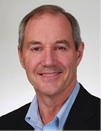
Every dealer wants — or needs — to sell more.
Whether it's from your manufacturer's demand for market share or machine population, or your need for more revenue, dealers continue to look for ways to boost sales. A good place to start selling more machinery is to look first at your parts and service departments. There is a strong link between sales coverage and better parts and service profitability — meaning better absorption.
From our work with dealers over the last 35 years, we have examined why some dealers are achieving their revenue growth and market share targets while others are not. The latter often complain that they're spending too much on their sales effort for the results they achieve.
The short answer for the difference in results is that the top performing dealers have more salespeople, and manage them better than the average or poor performing dealership. There are reasons why the top performers have more salespeople, which we've discovered by studying the characteristics of dealers at various levels of performance.
'Balanced' Sales Mix
Let's focus on the high performing dealers from whose success we can learn. Of the characteristics, there are three that stand out:
1. Strong Consistent Sales Manage-ment
2. Assigned Accounts & Accountability
3. Balanced Sales Mix (represented by strong absorption)
In previous Planning for Profit columns, we've discussed the differences between sales management and account management. In this edition, we'll focus on a balanced "Sales Mix" and how it contributes to more wholegood sales.
The fact is high performing dealers have better coverage because they have higher absorption — not the other way around! Because they have high absorption, these dealers are more confident about the condition of their business and with this confidence they're comfortable spending more on salespeople than average or low performing dealerships. More salespeople means more sales!
Defining Absorption
Total Gross Profit from Parts, Labor and Rent-to-Rent Business divided by Total Dealership Expenses.
Some companies modify this by additionally subtracting sales personnel expense, or variable sales department expenses from the total dealer expenses.
A 'Strong' Mix
The strategic difference for the dealers in this high performing category is that they are focused on selling after-market or product support as well as machinery. They have a strong sales mix which includes parts, labor and rental volume. They achieve solid gross profits in these three departments and manage their expenses well.
The high performance dealers did not start by increasing service or parts sales. Their perspective is to provide complete and total solutions for their customers. They want to capture all of the spending from these customers.
They don't look at a prospect as only a potential equipment sale. Instead, they look at the potential for winning all of the customer's business. This includes adding complementary product lines, if it helps provide a total solution for the customer.
Their initial approach is to deepen the penetration of sales into existing accounts by selling more parts and service, as well as capturing new customers by selling their parts and service capability. This strategic total account selling means, as a company, they value the customer, and see more total potential business from each account.
To illustrate this concept, let's look at the total sales and profit potential over 10 years for one hypothetical customer as shown in the table below. Consider a customer who purchases $2.5 million in equipment over that period with a 10% margin, or $250,000 in gross profit from machine sales.
In this example, this customer provides $37,000 of net profit from machine sales after all expenses, but the entire potential for parts and service is worth almost that much again. The total account will cover $167,000 in payroll expenses, plus the $35,000 in service wages (Cost of Goods Sold). The entire account will bring in $200,000 in wages and personnel expense coverage in 10 years. This is a much different perspective for expense coverage and profits than just looking at the sales commission on wholegoods.
Given the approach to customers for their total business, these high performing dealers build a stronger dealership from the ongoing revenue stream of aftermarket sales. Because it's a dealership with a high sales mix from parts and service, they maintain good gross profits and cover their total expenses, which means they're also achieving a high absorption rate.
But these high performing dealers do something that the average and weak dealerships don't do — they spend money!
From our research we find that dealers who were at or near 100% absorption spend on average 17% more on wholegoods salespeople compared to dealers with lower absorption.
Because these high performing dealers are confident of covering their total dealership expenses, they're more willing to hire more salespeople. Putting aside the better sales management and sales process characteristics of high performing dealers, by employing more salespeople these dealerships have more "feet on the street," more awareness of what deals are happening and more closed sales. Because of their approach, they spend more on salespeople in the field to sell parts and service as well as wholegoods.

Sales or Absorption?
So, what comes first, the chicken or the egg? In this case we know the answer — THE CHICKEN! And the chicken represents solid absorption.
When the dealer has a strong absorption rate, they invest more in salespeople. Those sales people visit more accounts, see and quote more deals and close the sales!
So, if you want to be a high performing dealer, we recommend that you first start strategically focusing on the total account potential, develop your business to achieve 100% absorption, and then aggressively add more salespeople.
You'll be glad you did.








